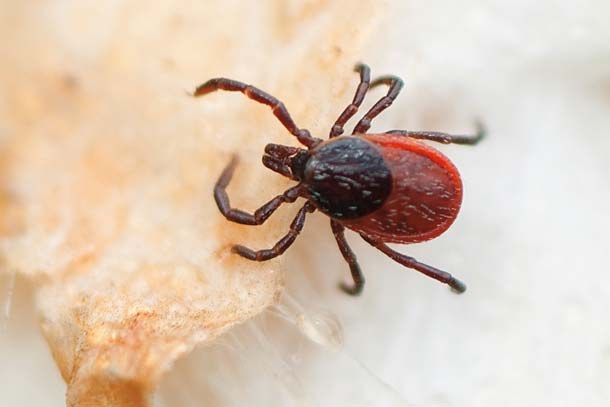Back East, it seems everyone has a story to tell about ticks. My brother, for example, narrates with horror a time he trudged across some overgrown farm fields in Michigan early one evening, only to look down and see dozens of dark specs on his legs; he was covered in the eight-legged bloodsuckers.
Locals to the Bay Area sometimes forget about the hazards of these little predators when exploring nature. But maybe they shouldn’t. Ticks carry Lyme disease, a debilitating condition caused by a bacterial infection ticks pick up from biting deer and mice.
“Some physicians tell their patients that Lyme disease doesn’t exist in California or is very rare,” Dr. Bob Lane said, a UC Berkeley entomologist. “Lyme disease is locally an issue in some Bay area counties, such as in Sonoma and Marin.”
Fewer tick species live on the West Coast, but there are enough of them to carry six different diseases. Lyme disease accounts for over 80 percent of tick-borne diseases in California, according to Lane. He has studied Lyme and other tick-borne diseases in California for over 35 years.
In California, the disease occurs most commonly in the Northwest coastal counties and right here in the Bay Area, which averages five to six cases each year, according to the Centers for Disease Control and Prevention (statewide the rate of contraction is quite low: 0.3 per 100,000 persons each year).
The symptoms of Lyme disease are difficult to diagnose. They range from an expanding circular rash to flu-like illness to cognitive problems. If not caught early, the disease can be difficult to beat.
Preventing Lyme disease
As spring draws to a close, ticks will be in their peak phase of abundance as young juveniles, ending mid-summer. Juveniles at this stage are also most likely to contract Lyme disease, Lane said. With the warmer weather and start of hiking season, it’s also the time of year when people are most likely to come in contact with ticks infected with Lyme disease
The best ways to limit exposure is to wear protective clothing, use repellents, and do regular tick checks on hair and clothing. Nymphal ticks, in the second juvenile stage, are about the size of a poppy seed.
“If you don’t mind looking like a nerd, tuck pants into socks,” Lane said, although he admits to “living dangerously” and not always practicing his own advice.
Curiously, Lane said the overwhelming majority of young ticks in north-western California attach to lizards, and especially the western fence lizard. Fortunately for us, this widespread lizard contains, within its immune system, the power to kill the bacteria of Lyme disease. When a tick bites a western fence lizard and has Lyme disease, the bacteria will die and neither the tick nor lizard will carry the disease.
Lane and others who’ve studied this specialization think this is the primary reason why the infectious rate of Lyme disease is so low in California, and why so few adult ticks carry the infection.
“The lizard appears to be cleansing affected nymphal ticks, and in some sense doing humankind a service,” Lane said.
Where to beware
Contrary to popular belief, ticks do not fall from trees, and it’s not hiking that’s the problem per se. Rather, entering tick habitats is what puts you at risk for becoming tick bait. Contact with wood is the most dangerous spot to be in.
Lane has seen the greatest amount of young ticks in oak and Douglas fir woodlands, living in leaf litter and crawling on logs. A behavioral study conducted by Lane proved that sitting on logs is the riskiest behavior when it comes to ticks during this time of year.
A transitional area from one type of habitat to another, such as the conjunction of woodland and grasslands, also holds high populations of young ticks, Lane said.
Beware especially when clearing brush along a forests edge, such as during trail maintenance projects. Hilly areas, such as the coast ranges, can host a higher abundance of ticks.
—
For more information on ticks and Lyme disease:
* A lab in Palo Alto where you can send a tick to be tested for Lyme disease.
* California Lyme Disease Association.
* Tick management handbook.


-300x200.jpg)
-300x198.jpg)
-300x218.jpg)